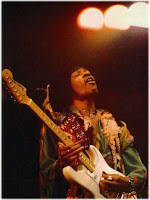Distortion Explained Part 1
 It is hard to think about the
sound of an electric guitar without thinking about distortion. There was a time when
electric guitars were always clean. Hard to imagine now.
It is hard to think about the
sound of an electric guitar without thinking about distortion. There was a time when
electric guitars were always clean. Hard to imagine now.
Traditionally distortion was an unwanted
feature in amplifier design. Distortion only occurred when the amp was
damaged or overdriven. Possibly the first intentional use of distortion
was in the 1951 recording of “Rocket 88″ By Ike Turner and the Kings of
rhythm.
Chuck Berry liked to use small tube amps
that were easy to overdrive for his trademark sound and other guitarists
would intentionally damage their speakers by poking holes in them,
causing them to distort.
Leo Fender then started designing amps
with some light compression and slight overdrive and Jim Marshall
started to design the first amps with significant overdrive. That sound
caught on quickly and by the time Jimi Hendrix was using Roger Mayer’s
effects pedals, distortion would forever be associated with the electric
guitar.
Not just for guitars
When you're recording and mixing, you can use a bit of distortion to give any sound more edge, grit, energy and excitement. Drums, vocals, bass, samples - they can all benefit from a touch of distortion at times. Understanding the different ways distortion can be created and how they sound can help you get better sounds and make better recordings.
Not just for guitars
When you're recording and mixing, you can use a bit of distortion to give any sound more edge, grit, energy and excitement. Drums, vocals, bass, samples - they can all benefit from a touch of distortion at times. Understanding the different ways distortion can be created and how they sound can help you get better sounds and make better recordings.
So What Is Distortion?
The word distortion means any change in
the amplified waveform from the input signal. In the context of musical
distortion this means clipping the peaks off the waveform. Because both
valves and transistors behave linearly within a certain voltage region,
distortion circuits are finely tuned so that the average signal peak
just barely pushes the circuit into the clipping region, resulting in
the softest clip and the least harsh distortion. Because of this, as the
guitar strings are plucked harder, the amount of distortion and the
resulting volume both increase, and lighter plucking cleans-up the
sound. Distortion adds harmonics and makes a sound more exciting.
Amp Distortion
Valve Overdrive
Transistor Clipping
So that is basically how Tube and Solid
state amps create distortion. Let’s talk about some different types of
distortion sounds as found in effects pedals.
Tape Saturation
Part 2 will cover the differences between various types of guitar distortions - Overdrives, Fuzz, hi-gain and more.
No comments:
Post a Comment